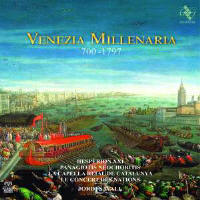Texte paru dans: / Appeared in: |
|
|
Outil de traduction ~ (Très approximatif) |
|
|
Reviewer: J.
F. Weber
Don’t think that this account
of the history of Venice will duplicate all the usual Venetian composers in
your collection. Quite the contrary: Except for a few familiar works, this
program focuses on more obscure aspects of the Most Serene Republic’s
relationship to the East. It duplicates none of the Venetian music from a
narrower time frame that we heard on a recent disc, Venezia Mundi Splendor
(Fanfare 41:4), or on another similarly titled disc (39:4), or on Music for
San Marco in Venice (27:5), or on Venice, Splendour of the World on
Dervorguilla back in 1995. There’s no use repeating the detailed account of
the thousand-year history as summarized by Savall in seven chapters of 35
sections, illustrated by 37 pieces of music. A few highlights of the history
are the settlement in the lagoon around 700; bringing the relics of St. Mark
from Alexandria in 828 to make him the city’s patron, for which the basilica
of San Marco was later erected in Byzantine style; the city’s part in the
reconciliation of the emperor Frederick Barbarossa with Pope Alexander III
in 1177; bringing the four bronze horses of antiquity to San Marco after the
sack of Constantinople in 1204; Marco Polo’s return to Venice from China in
1295; the city’s centuries-long domination of trade in the eastern
Mediterranean; its role in the short-lived healing of the schism in 1439;
Venice’s dominant position in shipbuilding, printing, painting, and
architecture.
In addition to Savall’s three
ensembles, the name of Panagiotis Neochoritis, the cantor of the Greek
Orthodox Patriarchate of Constantinople, appears, directing a vocal ensemble
from Thessalonica on eight tracks. Another track is credited to an Armenian
soloist, and one to a Hebrew singer. Other participants are musicians from
Morocco and Turkey, performing works of Byzantine, Berber, Ottoman, Cypriot,
Slavonic, and Persian origin; they join Savall’s ensembles in nine tracks.
Many of the works are anonymous, and many are Savall’s own arrangements of
relevant European music as well. Mozart’s visit in 1771 is noted by Savall’s
arrangement of his Turkish March, a nod to the importance of Venice’s close
relations with Turkey. Certainly the most unusual is the concluding 10
minutes, where Savall marks the fall of Venice to Napoleon’s troops and its
annexation to Austria (not to Napoleon’s Italian Republic, as stated once on
page 11). He makes a choral arrangement of Luigi Bordese’s La sainte Ligue
after a text of Adolphe Joly, incorporating the Allegretto of Beethoven’s
Symphony No. 7 and the finale of his Symphony No. 5.
Of the works singled out,
Marcabru’s song includes only the first two verses. Du Fay’s lament features
Pascal Bertin as soloist in a performance twice as long as average;
Janequin’s familiar battle song is a splendid rendition. Monteverdi’s
much-recorded Crusader tale, by far the longest work on the program,
features the excellent Furio Zanasi in his third recording as the narrator,
a suitably dramatic performance. Oddly, Marcabru’s Crusade song marks the
Fourth Crusade, but Monteverdi’s tale of the Crusader Tancredi commemorates
merely the staging of the work in 1638.
I have found Savall’s previous
bound volumes to be remarkably well-constructed programs. His appreciation
of the history and culture of the Mediterranean nations shines through every
time. He outlines the history of each subject and illustrates it with
musical selections marking the eras, acknowledging the assistance of
numerous specialists in assembling the program and the book. The book
consists of 340 pages, partly accounted for by the original and five
translations of the notes, which fill 29 pages in each version. There are
five essays, one by John Julius Norwich, the author of A History of Venice
(Knopf, 1982); one by Judith Herrin, the author of Byzantium: The Surprising
Life of a Medieval Empire (Princeton, 2007); one by Lucette Valensi, the
author of Venice et la Sublime Porte: La naissance du despote (Hachette,
1987); one by Sylvie Mamy, the author of La musique à Venise et l’imaginaire
français des Lumières (Paris: BNF, 1996); and a short introduction by
Savall. (Norwich’s essay was so compelling that I immediately ordered his
book; the bibliography lists eight other books besides these.) The five
essays tell the same history, but each author adds his or her own details to
accounts that are partly repetitious. There are 19 color photos of the musicians and over 30 reproductions of art, all of remarkable beauty and interest, many in full-page or double-page format. There is too much to cite everything: to name one, the portrait of Sultan Mehmet II, the Conqueror, which Bellini went to Constantinople to paint in 1453, now in the National Gallery in London. The texts are printed with six translations. The essays are marred by a few inconsequential faults of translation and proofreading, not enough to impair comprehension. The detailed table of contents fills six pages, though one might miss the identities of the performers on each track that are found only in the original French version. The recordings have been selected from three concerts of this program performed in Fontfroide, Salzburg, and Utrecht during 2016. In early 2017, the program was also performed in New York and Washington. This is another magnificent production that Alia Vox has undertaken on behalf of Jordi Savall. It would make a marvelous gift for anyone interested in the history or the music, coming out just in time for graduation. | |
|
|
|
|
|
|
|
Cliquez l'un ou l'autre
bouton pour découvrir bien d'autres critiques de CD |
|




